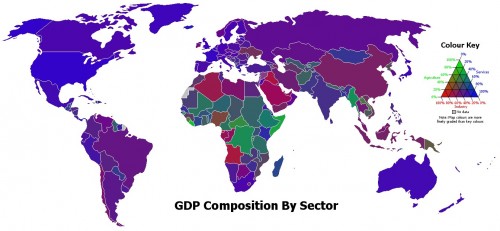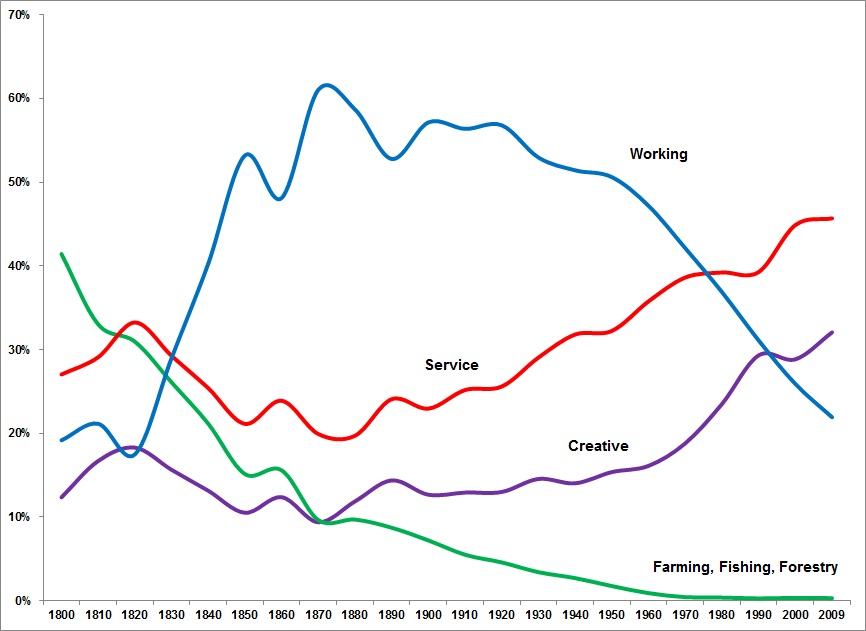Fundamentally, development is about systematically doing things better than they were done before. The fundamental objective of development is to establish a widely effective, indigenous process of rapid improvement in the way things are done. (From an earlier post.)
I recently posted on "
Development at the Village Level". I wish to expand the thoughts expressed in that post. Think of development as institutionalizing a nationwide process in which many, many things are done better and better over time.
Village development is a theme of great importance to the poorest nations; in them subsistence agriculture employs large numbers of people and produces much of the GDP. However, as people in the rural areas increase their productivity, fewer will be needed to work the land, and a smaller and smaller portion of the national population is needed to meet the needs for food and fiber. (This is true even including the needs for agricultural exports.) With fewer people working the land, people will move from farms and villages to towns and cities. Moreover, the demand for manufactured goods and for services will increase, and jobs will be created meeting those demands.
This post is about urbanization and structural change of the economy as development processes. Both depend on cultural change, and both lead to cultural change, but I don't really understand those complex cultural processes well enough to venture to discuss them.
Urbanization
I recommend these three videos by Steve Holloway introducing Central Place Theory if you are not familiar with the subject:
They explain that there is a natural process by which towns and villages develop in any society. Villages and small towns will provide common goods like groceries to the people that live in and near them. Larger towns and cities will provide a more diverse variety of goods and services, including those that are in less demand and thus requiring a larger potential customer base to service. As is obvious, the stores in cities serve the residents of cities but also from smaller towns and villages around them.
What Holloway does not say is that businesses serving consumer needs tend to flock together, in part because consumers like to shop where there are a number of stores. Thus we see suburban shopping malls, and downtown business districts. Thus the catchment area for a town will be larger if it has a larger variety of goods on sale.
Think of health services. In the village in a poor country, you might find paraprofessional or traditional health workers -- say a health promoter or a midwife. People from the village might have to travel to the nearest town to find a health center, and to the nearest city to find a good hospital. University teaching hospitals would be found only in a few cities, typically the largest. While learning would take place at all these levels, technological innovations would normally come from the outside, or trickle down from the teaching hospitals, medical schools and ministry of health.
Education might be seen as similarly geographically hierarchical. Villages and urban slums might have their primary schools, but with high drop out rates, fewer children would attend secondary schools than primary, and fewer would get tertiary schooling than secondary. Secondary schools would be located in towns rather than villages; tertiary schools would be even fewer in number and often located in still larger towns and cities. In the United States, for example, while there are thousands of colleges and universities, there are just over 100 research intensive universities that do most of the PhD training in sciences; each of these will draw even international students. While teachers and school administrators can be expected to learn how better to do their jobs on the job, good school administration should be innovating and improving opportunities for students to learn. We also see colleges and universities providing opportunities for teacher ongoing education, and computer hardware and courseware firms providing technological innovations to the schools.
Holloway also fails to say that towns and cities are also where manufacturing takes place. Factories tend to be located where they can obtain the raw materials that they need for their production, and where the infrastructure allows; they need power and access to appropriate transportation, as well as communications. Factories also need people, but people will be drawn to move to towns offering jobs in factories when the local labor force proves too small to supply them. Thus, contrary to Holloway's simple model, towns and cities are often located both to serve the needs of both stores and factories.
We also know that manufacturing companies tend to cluster. Bigger towns having more factories allow for positive spill-overs among them. Factories manufacturing intermediate goods sell to factories manufacturing final goods via markets for those intermediate goods. Tool makers, engineering firms and other service firms spring up to serve the factories. Trade schools prepare skilled workers to serve in the factories. Banks specializing in serving the industrial financial needs come into existence.
Government decisions influence the growth of towns. These decisions include where to build roads, whether and what kind of tax incentives to offer to companies to locate in their towns, the schools governments provide to educate people who will become workers, and the security they provide to property and citizens. But towns also grow where the natural environment is propitious, which is why one sees cities on sea coasts and large rivers, and knowledge-based industries in locations with good climates and physical beauty.
Obviously too, the decisions of individuals and of private firms also influence the growth (and decay and death) of towns and cities. Changing the ways these decisions are made on a scale to affect the rate and character of urban change clearly is a cultural change -- not simply a matter of creating a new government agency or policy.
One aspect of development then is improving the ways towns and cities are created and grow, and how they incorporate productive activities within them. That aspect of development includes improving decisions as to how towns and cities should be supported when their economies become troubled, and when and how they should be allowed to depopulate when their purposes are challenged. This urban development involves decisions made by individuals, families, communities, governments and businesses.
Clearly many countries are concerned that things are not going well in this aspect of development. The United States is concerned about "rust belt" cities that have lost their industrial purposes and are decaying and perhaps dying. Other countries are concerned that their largest cities have grown so large as to be unstable. Still others are concerned that the rate of urban growth, and especially the rate of growth of slums inhabited by new immigrants is unhealthy.
As the graph (taken from
an article in
The Economist) shows, comparable societies have different patterns of urbanization. The United States has bigger cities than does the Euro zone, even though both have similar total populations. The article further states:
Differences in metropolitan populations may help explain gaps in productivity and incomes. Western Europe’s per-person GDP is 72% of America’s, on a purchasing-power-parity basis. A recent study by the McKinsey Global Institute, the consultancy’s research arm, reckons that some three-quarters of this gap can be chalked up to Europe’s relatively diminutive cities. More Americans than Europeans live in big cities.
Structural Change
Traditionally we divided the economy into primary industries (farming, mining, forestry, fishing), secondary industries (e.g. manufacturing) and service industries (e.g. financial services, retail and wholesale trade, education, health). I recently posted
graphs showing how the U.S. GDP has evolved since World War II, with primary industries greatly declining in relative importance, as service industries increased greatly in importance.
The graph above shows how U.S. employment has evolved since 1972., as the portion of the workforce employed in manufacturing has been significantly reduced (both by automation, and by a shift toward more capital intensive and less labor intensive manufacturing), while employment in the service sector has become dominant.
Note that the GDP has grown fairly consistently since World War II (with the exception of the recent Great Recession), but median household income has not grown greatly in recent decades, with the greatest part of the increase in GDP captured by the most affluent.
The graph above, using that same tripartite classification, shows that some regions are still dominated by the primary sector (green, notably in Africa), others by services (blue, notably North America, western Europe, and Australia), while a few areas (notably China) have redder coloring indicating their economies' greater industrial dependence.
A more recent taxonomy divides workers into four groups
- Agricultural
- Working, including all blue-collar physical work, including construction, transportation and maintenance
- Creative -- workers in science and technology, arts, culture and entertainment, healthcare, law and management, whose occupations are based on mental or creative labor
- Service -- people who prepare and serve food, carry out routine clerical and administrative tasks, provide home and personal health assistance, do janitorial work, and the like.
The following graph gives an estimate of the evolution of the proportions of U.S. workers in each of these four groups since 1800.
Thus development is seen as a process in which the economy turns from extracting things from nature, to making things, to providing services, and perhaps more recently, to creating ideas and conceptual products. Development can be seen as a nation first satisfying its needs for food and shelter, to then also satisfying its needs for goods (better clothing, housing, transportation), and then to improving health, educational and government services and making it easier to obtain goods and services, to finally entertaining itself.
How does a nation move through this progression? Clearly its workers must become more productive in the tasks that that nation is already carrying out, while new enterprises must be created to accomplish things new to this specific society. For poor countries, the new enterprises will often be created by transferring technology from abroad, perhaps with green field financing and foreign managers and technical experts. Even then, such enterprises will benefit from related experience within the country, and may be located in clusters of related enterprises (with their supporting educational, training, financial and other services). Countries already at the forefront of technology will emphasize invention. Sometimes, of course, even in poor countries, nationals will invent their own new products and processes, and create their own enterprises to utilize the processes to produce the products. However they arise, people will have to learn to carry out the tasks in these new enterprises, and to find ways to perform the tasks better over time.
Of course, society will have to create the welcoming environment to encourage appropriate evolutionary transformation of the economy. It will have to accept a process of creative destruction, allowing outdated economic activities to end, and encouraging new ones to start. It will have to be agile in dealing with change. Corruption is destructive to the process, as is rent seeking by those in power. A dynamic society -- one that is quickly developing through the transformation of its economy -- should expect frequent failure of new enterprises and enterprise zones, and learn from them. It should help the members of the society accommodate to the dislocations that the changes will involve on the individual, household and community level.
Several things seem obvious. Economic transformation and economic growth are intimately connected, and indeed a nation that successfully manages the process of economic transformation for decades has almost by definition improved per capita GDP. However, the process of developing new industries that take full advantage of the resource endowment of the nation is complex and people differ greatly on how it should be done. Moreover, economic transformation also involves unsuccessful experiments and destruction of once useful industries when they have lost their competitive advantage -- both processes in which some people lose. The best way to institutionalize the destructive aspects of economic transformation is the subject of uncertainty and controversy.
Monitoring and Evaluation
I began this short series on development thinking about monitoring and evaluation, and especially about the use of randomized controlled trials (RCTs). I started my career in international development as a Peace Corps volunteer, and I recall disasters. One such disaster was a community that was convinced to make thousands of cement reinforced adobe bricks and then found out that the residents could not get financing to build homes from those bricks because they would not survive in the local climate. People have too often been encouraged to adopt the wrong technology, and RCTs can help to reduce that problems.
However, RCTs would seem to have little place in monitoring the processes of urbanization and structural transformation. Those seem to me to be complex, specific to individual regions and countries and dependent on historical and cultural details. Moreover, urbanization and structural transformation are related to each other and fundamental to development. How then would one include appropriate monitoring and evaluation of these processes so fundamental to development?
Clearly, M&E should be data based/ There should be data on urbanization, not only from census records, but perhaps also from new technologies -- perhaps drone based remote sensing and computerized geographic information systems. There should be data on production and employment in the economy, with finely disaggragated classification of the productive enterprises, linked to the same geographic information system.
Clearly, M&E should be based on historical data and trend analysis. It should also be based on projection of trends of urbanization and economic transitions into the future. I would hope that the projections of these trends in urbanization and transformation of the economy would involve well developed models, based strongly on theory, and incorporating current and historical data.
Do benchmarks have a use? I guess so. Still, deviation from a benchmark would need to be interpreted, and appropriate responses developed.
My preference for judgments related to the monitoring and evaluation of these development processes would be a two part effort:
- professional appraisal done by economists, industrial development experts, demographers and others with strong theoretical foundations and analytic interests, and
- political appraisal done by legitimate decision makers from government, the private sector and civil society.











































